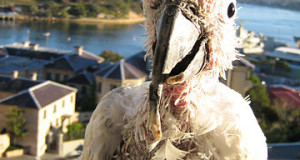Interesting….but I think bird keepers have known this to be true for quite some time. Most of us learned early on that parrots focus on our eyes when watching us, and that the best way to sneak up on a bird that is reluctant to return to its cage is to observe it by quick, side-wise glances. This is a good point to keep in mind when watching newly acquired finches and other shy pets.
In fact, a key to being able to get a good look at the birds I worked with in large zoo exhibits was to avoid a direct stare. Birds feeding calmly not far from me would immediately fly off if I shifted my glance, even if the rest of my body remained immobile. I had first learned this lesson in the wonderful book Hand Taming Wild Birds at the Feeder, by Alfred G. Martin (Bond Wheelwright Co., 1963), and was subsequently able to induce a variety of birds to feed from my hand.
I have a bit of evi dence that birds “know” the meaning of other human facial features as well. I once helped to raise a barn owl, Tyto alba, that had been found on a Bronx street (yes, a surprising number of birds do live there!). The bird imprinted on people (came to view us as its “parents”), which suited it well for us in educational programs. As hand-raised birds will do, this male owl sought a human “mate” when it matured. In typical barn owl fashion, it would bring any nearby keeper a mouse – perching on our shoulders and trying to stuff its lovely nuptial gift into our mouths! Never once did the owl try an ear or eye – it seemed to be able to make, in its brain, the quite large transition from bird beak to human mouth.
dence that birds “know” the meaning of other human facial features as well. I once helped to raise a barn owl, Tyto alba, that had been found on a Bronx street (yes, a surprising number of birds do live there!). The bird imprinted on people (came to view us as its “parents”), which suited it well for us in educational programs. As hand-raised birds will do, this male owl sought a human “mate” when it matured. In typical barn owl fashion, it would bring any nearby keeper a mouse – perching on our shoulders and trying to stuff its lovely nuptial gift into our mouths! Never once did the owl try an ear or eye – it seemed to be able to make, in its brain, the quite large transition from bird beak to human mouth.
 That Bird Blog – Bird Care and History for Pet Birds
That Bird Blog – Bird Care and History for Pet Birds




